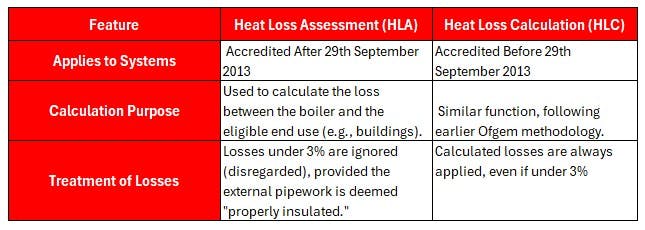Heat Loss Assessments (HLA/HLC) for Pipework: Securing Your RHI Payments
The Benefit of Accounting for Pipe Losses
For your Non-Domestic RHI installation, securing continuous tariff payments requires precise metering. This can be done one of two ways. The first is to have multiple meters that measure the eligible heat use at different buildings or processes, the kWh shown on each meter is totalled and that is what your payments are calculated against. The second method is based on measuring the eligible heat generation (the meter next to the biomass boiler), then calculating the heat loss across all external pipework which either gets disregarded if certain criteria is met (so you get paid for 100% of the kWh shown on the generation meter), or you have a quarterly heat loss figure deducted from the generation meter.
The benfits of a heat loss account are that you reduce tha number of heat meters needed so lowers the installation or replacement costs, and the calcualted losses are less than you see in reality which ultimately ends up in increased RHI payments for the same usage. The Heat Loss Assessment (HLA) and Heat Loss Calculation (HLC) are the two official methodologies used to determine these losses.
As specialists in RHI compliance, Treco provides the verifiable documentation required to accurately assess these losses, ensuring your system remains accredited and your payments are secure.
Understanding RHI Pipe Loss Methodologies: HLA vs. HLC
The method used to calculate losses from the heat transfer fluid (water or air) conveyed through external pipes depends on your system's RHI accreditation date, a breakdown on this is provide below:

Heat Loss Assessment (HLA)
A Heat Loss Assessment (HLA) is used for systems accredited under the RHI after 29th September 2013.
It’s designed to calculate how much heat is lost between the biomass boiler and the eligible end use, such as buildings or drying systems etc. The lower the losses, the higher the proportion of heat that counts towards RHI payments.
With an HLA, losses under 3% are normally ignored, provided all external pipework is properly insulated. The underground heat main is automatically considered well insulated, but above-ground external pipework must meet specific insulation.
To be considered properly insulated under RHI guidance, insulation should generally:
- Have a thermal conductivity (λ-value) of 0.025 W/m·K or better at 40°C
- Be weather-resistant and moisture-proof for outdoor use
- Be installed continuously, with all joints and fittings sealed
- Comply with BS 5422 (the British Standard for thermal insulation of pipework and equipment in the temperature range −40°C to +700°C).
Ofgem typically references BS 5422 in its technical guidance as the measure for “adequate insulation.”
If the heat losses exceed 3%, or there are areas of pipework that don’t meet insulation requirements, those losses are factored in and reduce the eligible heat total.
Heat Loss Calculation (HLC)
A Heat Loss Calculation (HLC) applies to systems accredited before 29th September 2013. It performs a similar function to an HLA but follows the earlier version of Ofgem’s methodology.
The key difference is that with an HLC, the calculated losses are always applied, even if they are under 3%. That means older systems tend to have a slightly lower eligible heat figure compared to those accredited later under HLA rules.
As with HLAs, the purpose is to ensure that only genuine renewable heat use is rewarded under the RHI scheme.
Independent Report on Metering Arrangements (IRMA)
An Independent Report on Metering Arrangements (IRMA) is a formal technical report prepared by a qualified independent engineer. It describes how heat is measured on an RHI-accredited system and confirms that the setup meets Ofgem’s metering requirements.
An IRMA is required:
- When an HLC is carried out (for all pre-2013 installations)
- If calculated losses from an HLA are above 3%
- Where there is any ineligible heat use, for example heating a swimming pool or other non-qualifying use
The IRMA ensures that the system is metered correctly and that any deductions for ineligible use or heat losses are accurately applied.
For most modern systems with well-insulated pipework and no ineligible heat use, an IRMA isn’t normally needed. However, Ofgem can request one at their discretion, so it’s sensible to be aware of the requirement.
Why these reports matter
Understanding whether your system is assessed under an HLA or HLC, and whether an IRMA is required, helps ensure your metering setup stays compliant. When replacing a heat meter, these reports may need updating, especially if any part of the system has changed since the original installation.
Having accurate, up-to-date documentation prevents delays in RHI amendments and avoids the risk of payment suspensions during Ofgem checks.
How can Treco Help?
Treco’s team has extensive experience supporting customers with RHI heat meter replacements, HLAs, HLCs, and IRMAs. We can help review your setup, identify what type of assessment applies, and manage the submission of any required updates to Ofgem.
Why Treco is the UK Specialist for RHI HLA & HLC
While many firms offer consultancy, Treco provides the unique advantage of expertise that spans both calculation and installation.
- Biomass Installation Heritage: We've been designing and installing biomass systems for 20 years. We apply real-world knowledge of how biomass boilers operate, including fuel characteristics and efficiency profiles, to our calculations.
- Complex Systems Expertise: Our team specialises in large and complex installations, including district heating networks. We accurately model pipe heat losses and staggered demand to size the central plant effectively.
- Project Modification Support: If you are modifying an existing RHI-accredited system (e.g., adding a new wing or process), we assess the new total heat demand against the current capacity. This is crucial for managing the necessary system change notifications or re-accreditation applications with Ofgem.